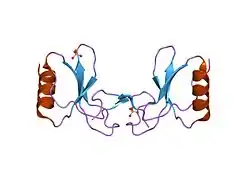CCL5
CCL5 (englisch CC-chemokine ligand 5) ist ein Zytokin aus der Familie der CC-Chemokine.
| CCL5 | ||
|---|---|---|
 | ||
| nach PDB 1EQT | ||
| Andere Namen |
| |
|
Vorhandene Strukturdaten: 1B3A, 1EQT, 1HRJ, 1RTN, 1RTO, 1U4L | ||
| Eigenschaften des menschlichen Proteins | ||
| Masse/Länge Primärstruktur | 91 Aminosäuren, 9990 Da | |
| Bezeichner | ||
| Externe IDs | ||
| Orthologe | ||
| Mensch | Hausmaus | |
| Entrez | 6352 | 20304 |
| UniProt | P13501 | P30882 |
| PubMed-Suche | 6352 | 20304 |
Eigenschaften
CCL5 ist an Entzündungsprozessen beteiligt. CCL5 wird unter anderem von zytotoxischen T-Zellen gebildet und bindet T-Zellen, Monozyten und Eosinophile durch Bindung der Rezeptoren CCR3,[1][2] CCR5[2][3][4] und CCR1.[2][4] CCL5 aktiviert den GPCR GPR75.[5]
CCL5 ist an der Abwehr von Infektionen mit HIV-1 beteiligt,[6] da es die Bindung von HIV an seinen Korezeptor CCR5 kompetitiv hemmt.
Einzelnachweise
- Daugherty BL, Siciliano SJ, DeMartino JA, Malkowitz L, Sirotina A, Springer MS: Cloning, expression, and characterization of the human eosinophil eotaxin receptor. In: J. Exp. Med.. 183, Nr. 5, May 1996, S. 2349–54. doi:10.1084/jem.183.5.2349. PMID 8642344. PMC 2192548 (freier Volltext).
- Struyf S, Menten P, Lenaerts JP, Put W, D'Haese A, De Clercq E, Schols D, Proost P, Van Damme J: Diverging binding capacities of natural LD78beta isoforms of macrophage inflammatory protein-1alpha to the CC chemokine receptors 1, 3 and 5 affect their anti-HIV-1 activity and chemotactic potencies for neutrophils and eosinophils. In: Eur. J. Immunol.. 31, Nr. 7, July 2001, S. 2170–8. doi:10.1002/1521-4141(200107)31:7<2170::AID-IMMU2170>3.0.CO;2-D. PMID 11449371.
- Slimani H, Charnaux N, Mbemba E, Saffar L, Vassy R, Vita C, Gattegno L: Interaction of RANTES with syndecan-1 and syndecan-4 expressed by human primary macrophages. In: Biochim. Biophys. Acta. 1617, Nr. 1–2, October 2003, S. 80–8. doi:10.1016/j.bbamem.2003.09.006. PMID 14637022.
- Proudfoot AE, Fritchley S, Borlat F, Shaw JP, Vilbois F, Zwahlen C, Trkola A, Marchant D, Clapham PR, Wells TN: The BBXB motif of RANTES is the principal site for heparin binding and controls receptor selectivity. In: J. Biol. Chem.. 276, Nr. 14, April 2001, S. 10620–6. doi:10.1074/jbc.M010867200. PMID 11116158.
- Ignatov A, Robert J, Gregory-Evans C, Schaller HC: RANTES stimulates Ca2+ mobilization and inositol trisphosphate (IP3) formation in cells transfected with G protein-coupled receptor 75. In: Br. J. Pharmacol.. 149, Nr. 5, November 2006, S. 490–7. doi:10.1038/sj.bjp.0706909. PMID 17001303. PMC 2014681 (freier Volltext).
- Cocchi F, DeVico AL, Garzino-Demo A, Arya SK, Gallo RC, Lusso P: Identification of RANTES, MIP-1 alpha, and MIP-1 beta as the major HIV-suppressive factors produced by CD8+ T cells. In: Science. 270, Nr. 5243, December 1995, S. 1811–5. doi:10.1126/science.270.5243.1811. PMID 8525373.
This article is issued from Wikipedia. The text is licensed under Creative Commons - Attribution - Sharealike. The authors of the article are listed here. Additional terms may apply for the media files, click on images to show image meta data.